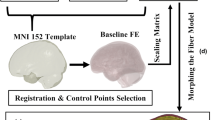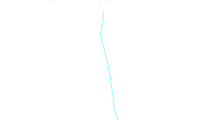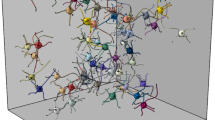Abstract
This study presents a novel statistical volume element (SVE) for micromechanical modeling of the white matter structures, with histology-informed randomized distribution of axonal tracts within the extracellular matrix. The model was constructed based on the probability distribution functions obtained from the results of diffusion tensor imaging as well as the histological observations of scanning electron micrograph, at two structures of white matter susceptible to traumatic brain injury, i.e. corpus callosum and corona radiata. A simplistic representative volume element (RVE) with symmetrical arrangement of fully alligned axonal fibers was also created as a reference for comparison. A parametric study was conducted to find the optimum grid and edge size which ensured the periodicity and ergodicity of the SVE and RVE models. A multi-objective evolutionary optimization procedure was used to find the hyperelastic and viscoelastic material constants of the constituents, based on the experimentally reported responses of corpus callosum to axonal and transverse loadings. The optimal material properties were then used to predict the homogenized and localized responses of corpus callosum and corona radiata. The results indicated similar homogenized responses of the SVE and RVE under quasi-static extension, which were in good agreement with the experimental data. Under shear strain, however, the models exhibited different behaviors, with the SVE model showing much closer response to the experimental observations. Moreover, the SVE model displayed a significantly better agreement with the reports of the experiments at high strain rates. The results suggest that the randomized fiber architecture has a great influence on the validity of the micromechanical models of white matter, with a distinguished impact on the model’s response to shear deformation and high strain rates. Moreover, it can provide a more detailed presentation of the localized responses of the tissue substructures, including the stress concentrations around the low caliber axonal tracts, which is critical for studying the axonal injury mechanisms.










Similar content being viewed by others
References
Abolfathi, N., A. Naik, M. Sotudeh Chafi, G. Karami, and M. Ziejewski. A micromechanical procedure for modelling the anisotropic mechanical properties of brain white matter. Comput. Methods Biomech. Biomed. Eng. 12(3):249–262, 2009.
Arbogast, K. B., and S. Margulies. Regional differences in mechanical properties of the porcine central nervous system. SAE Trans. 106:3807–3814, 1997.
Atashpaz-Gargari, E., and C. Lucas. Imperialist competitive algorithm: an algorithm for optimization inspired by imperialistic competition. In: 2007 IEEE Congress on Evolutionary Computation, 2007, pp. 4661–4666.
Barazany, D., P. J. Basser, and Y. Assaf. In vivo measurement of axon diameter distribution in the corpus callosum of rat brain. Brain 132:1210–1220, 2009.
Budday, S., G. Sommer, C. Birkl, C. Langkammer, J. Haybaeck, J. Kohnert, M. Bauer, F. Paulsen, P. Steinmann, E. Kuhl, and G. A. Holzapfel. Mechanical characterization of human brain tissue. Acta Biomater. 48:319–340, 2017.
Budday, S., G. Sommer, J. Haybaeck, P. Steinmann, G. A. Holzapfel, and E. Kuhl. Rheological characterization of human brain tissue. Acta Biomater. 60:315–329, 2017.
Chafi, M. S., G. Karami, and M. Ziejewski. Biomechanical assessment of brain dynamic responses due to blast pressure waves. Ann. Biomed. Eng. 38(2):490–504, 2010.
Cloots, R. J. H., J. A. W. van Dommelen, S. Kleiven, and M. G. D. Geers. Multi-scale mechanics of traumatic brain injury: predicting axonal strains from head loads. Biomech. Model. Mechanobiol. 12:137–150, 2011.
Costa, A. R., R. Pinto-Costa, S. C. Sousa, and M. M. Sousa. The regulation of axon diameter: from axonal circumferential contractility to activity-dependent axon swelling. Front. Mol. Neurosci. 11:319, 2018.
De Rooij, R., and E. Kuhl. Constitutive modeling of brain tissue: current perspectives. Appl. Mech. Rev. 68(1):010801, 2016.
Di Pietro, V. Potentially neuroprotective gene modulation in an in vitro model of mild traumatic brain injury. Mol. Cell Biochem. 375:185–198, 2013.
Gupta, R., X. Tan, M. Somayaji, and A. Przekwas. Multiscale modelling of blast-induced TBI mechanobiology—from body to neuron to molecule. Def. Life Sci. J. 2(1):3–13, 2017.
Hakulinen, U., A. Brander, P. Ryymin, J. Öhman, S. Soimakallio, M. Helminen, and H. Eskola. Repeatability and variation of region-of-interest methods using quantitative diffusion tensor MR imaging of the brain. BMC Med. Imaging 12:30, 2012.
Hill, R. Elastic properties of reinforced solids: some theoretical principles. J. Mech. Phys. Solids 11(5):357–372, 1963.
Hollister, S. J., and N. Kikuchi. A comparison of homogenization and standard mechanics analyses for periodic porous composites. Comput. Mech. 10(2):73–95, 1992.
Holzapfel, G. A., and R. W. Ogden. On the tension–compression switch in soft fibrous solids. Eur. J. Mech. A/Solids 49:561–569, 2015.
Hoursan, H., F. Farahmand, and M. Ahmadian. A novel procedure for micromechanical characterization of white matter constituents at various strain rates. Sci. Iran. 2018. https://doi.org/10.24200/sci.2018.50940.1928.
Javid, S., A. Rezaei, and G. Karami. A micromechanical procedure for viscoelastic characterization of the axons and ECM of the brainstem. J. Mech. Behav. Biomed. Mater. 30:290–299, 2014.
Johnson, C. L., M. D. J. McGarry, A. A. Gharibans, J. B. Weaver, K. D. Paulsen, H. Wang, W. C. Olivero, B. P. Sutton, and J. G. Georgiadis. Local mechanical properties of white matter structures in the human brain. Neuroimage 79:145–152, 2013.
Karami, G., N. Grundman, N. Abolfathi, A. Naik, and M. Ziejewski. A micromechanical hyperelastic modeling of brain white matter under large deformation. J. Mech. Behav. Biomed. Mater. 2(3):243–254, 2009.
Kouznetsova, V. Computational Homogenization for the Multi-scale Analysis of Multi-phase Materials. Eindhoven: Technische Universiteit Eindhoven, 2002.
Labus, K. M., and C. M. Puttlitz. An anisotropic hyperelastic constitutive model of brain white matter in biaxial tension and structural–mechanical relationships. J. Mech. Behav. Biomed. Mater. 62:195–208, 2016.
Latorre, M., E. De Rosa, and F. Montáns. Understanding the need of the compression branch to characterize hyperelastic materials. Int. J. Nonlinear Mech. 89:14–24, 2017.
Leemans, A., B. Jeurissen, J. Sijbers, and D. K. Jones. Explore DTI: A graphical toolbox for processing, analyzing, and visualizing diffusion MR data. In: 17th Annual Meeting of International Society of Magnetic Resonance in Medicine, Hawaii, USA, 2009, p. 3537.
Libertiaux, V., F. Pascon, and S. Cescotto. Experimental verification of brain tissue incompressibility using digital image correlation. J. Mech. Behav. Biomed. Mater. 4(7):1177–1185, 2011.
MacManus, D. B., B. Pierrat, J. G. Murphy, and M. D. Gilchrist. Region and species dependent mechanical properties of adolescent and young adult brain tissue. Sci. Rep. 7(1):13729, 2017.
Mazziotta, J., A. Toga, A. Evans, P. Fox, J. Lancaster, K. Zilles, et al. A probabilistic atlas and reference system for the human brain. International Consortium for Brain Mapping (ICBM). Philos. Trans. R Soc. Lond. B Biol. Sci. 356(1412):1293–1322, 2001.
McAllister, T. W., J. C. Ford, S. Ji, et al. Maximum principal strain and strain rate associated with concussion diagnosis correlates with changes in corpus callosum white matter indices. Ann. Biomed. Eng. 40:127, 2012.
Meaney, D. F. Relationship between structural modeling and hyperelastic material behavior: application to CNS white matter. Biomech. Model. Mechanobiol. 1:279–293, 2003.
Moerman, K. M., C. K. Simms, and T. Nagel. Control of tension-compression asymmetry in Ogden hyperelasticity with application to soft tissue modelling. J. Mech. Behav. Biomed. Mater. 56:218–228, 2016.
Ning, X., Q. Zhu, Y. Lanir, and S. S. Margulies. A transversely isotropic viscoelastic constitutive equation for brainstem undergoing finite deformation. J. Biomech. Eng. 128(6):925–933, 2006.
Pan, Y., D. Sullivan, D. I. Shreiber, and A. A. Pelegri. Finite element modeling of CNS white matter kinematics: use of a 3D RVE to determine material properties. Front. Bioeng. Biotechnol. 1:19, 2013.
Pesaresi, M., R. Soon-Shiong, L. French, D. R. Kaplan, F. D. Miller, and T. Paus. Axon diameter and axonal transport: in vivo and in vitro effects of androgens. NeuroImage 115:191–201, 2015.
Prange, M. T., and S. S. Margulies. Regional, directional, and age dependent properties of the brain undergoing large deformation. J. Biomech. Eng. 124:244–252, 2002.
Rashid, B., M. Destrade, and M. Gilchrist. Mechanical characterization of brain tissue in tension at dynamic strain rates. J. Mech. Behav. Biomed. Mater. 33:43–54, 2012.
Reuter, M., N. J. Schmansky, H. D. Rosas, and B. Fischl. Within-subject template estimation for unbiased longitudinal image analysis. Neuroimage 61(4):1402–1418, 2012.
Sepehrband, F., C. D. Alexander, K. A. Clark, N. D. Kurniawan, Z. Yang, and D. C. Reutens. Parametric Probability distribution functions for axon diameters of corpus callosum. Front. Neuroanat. 10:59, 2016.
Smith, H. D., and D. Meaney. Axonal damage in traumatic brain injury. Neuroscientist 6:483–495, 2000.
Takhounts, E. G., J. R. Crandall, and K. Darvish. On the importance of nonlinearity of brain tissue under large deformations. Stapp Car Crash J. 47:79–92, 2003.
Tsao, J. W. Traumatic Brain Injury: A Clinician’s Guide to Diagnosis, Management, and Rehabilitation. London: Springer, 2012.
Velardi, F., F. Fraternali, and M. Angelillo. Anisotropic constitutive equations and experimental tensile behavior of brain tissue. Biomech. Model. Mechanobiol. 5:53, 2006.
Wright, R. M., and K. T. Ramesh. An axonal strain injury criterion for traumatic brain injury. Biomech. Model. Mechanobiol. 11:245, 2013.
Wu, T., A. Alshareef, J. S. Giudice, et al. Explicit modeling of white matter axonal fiber tracts in a finite element brain model. Ann. Biomed. Eng. 47:1908, 2019.
Jin, X., F. Zhu, M. Haojie, S. Ming, and H. King. A comprehensive experimental study on material properties of human brain tissue. J. Biomech. 46(16):2795–2801, 2013.
Yousefsani, S. A., A. Shamloo, and F. Farahmand. Micromechanics of brain white matter tissue: a fiber-reinforced hyperelastic model using embedded element technique. J. Mech. Behav. Biomed. Mater. 80:194–202, 2018.
Yousefsani, S. A., A. Shamloo, and F. Farahmand. A three-dimensional micromechanical model of brain white matter with histology-informed probabilistic distribution of axonal fibers. J. Mech. Behav. Biomed. Mater. 88:288–295, 2018.
Zemmoura, I., E. Blanchard, P. I. Raynal, et al. How Klingler’s dissection permits exploration of brain structural connectivity? An electron microscopy study of human white matter. Brain Struct. Funct. 221:2477, 2016.
Funding
The funding was provided by Tehran University of Medical Sciences and Health Services (Grant No. 1398).
Conflict of interest
The authors declare that they have no conflict of interest concerning the contents of this article.
Author information
Authors and Affiliations
Corresponding author
Additional information
Associate Editor Xiaoxiang Zheng oversaw the review of this article.
Publisher's Note
Springer Nature remains neutral with regard to jurisdictional claims in published maps and institutional affiliations.
Appendix
Appendix
The flowchart of the optimization procedure is shown in Fig. 11.
Flowchart of the optimization procedure, based on the imperial competitive algorithm. \(\mu_{\text{axon}} , \mu_{\text{ECM}},\) α are material constants of OGDEN hyperelastic model. Also, \({\text{CF}}_{\perp}\) and \({\text{CF}}_{\parallel }\) stand for the cost functions defined as the deviations of the model and experimental responses in the transverse and axonal directions, respectively.
Rights and permissions
About this article
Cite this article
Hoursan, H., Farahmand, F. & Ahmadian, M.T. A Three-Dimensional Statistical Volume Element for Histology Informed Micromechanical Modeling of Brain White Matter. Ann Biomed Eng 48, 1337–1353 (2020). https://doi.org/10.1007/s10439-020-02458-4
Received:
Accepted:
Published:
Issue Date:
DOI: https://doi.org/10.1007/s10439-020-02458-4





